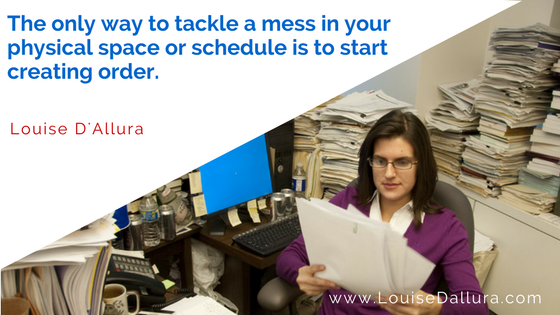If you want to be more productive and think clearer, get your office organised! According to the Journal of Neuroscience, clutter actually inhibits the brain’s ability to focus and process information. Researchers monitored task performance while mapping the brain’s responses to organised and disorganised stimuli. The results showed that when your environment is cluttered, your brain’s processing power decreases, as it has to vie for your energy and attention.
If you feel like you’re managing a mess on a daily basis check out these tips to cut your stress by creating order sooner rather than later (at work and at home) – don’t wait until it becomes an overwhelming job!
1) Everything in your home or office needs to have a home
Where the best place is, depends on where is logical and close to where you use/or look for an item. If it is an item you use every day, you need it to be within easy reach and readily accessible for everyday use. It is a good habit to train your ITEMS to return home. When an object strays from its ‘home,’ it can easily be lost, and these items build-up in random locations.
This doesn’t just apply to physical items. Remembering tasks, to-do’s, steps in a procedure count as well. Too often I see these written on wads of post-it notes around desks, computers, diaries and notebooks. These things to remember need homes too! Ask yourself WHERE this information needs to live so you can find it next time. Does this mean a process or checklist needs to be updated to house this important piece of information/ change to a process?
If you keep looking for the same document or write the same emails – create a home for templates of stock standard responses. Take the time to think through your work and actually LOOK at what needs homes.
2) Choose ONE AREA or System that you rely on daily.
This might be your desk, your inbox or it might even be your time. Whatever is causing you the biggest grief – stop wasting your precious time, your energy and your money tolerating a really really inefficient system. If you keep re writing your to-do list, or it’s reams of paper – you might want to start there!
3) Allocate 30 minutes to PLAN how you will tackle it
Break it down into little jobs and schedule it in. Focus on one thing at a time instead of cluttering your mind with multiple tasks. Multi-tasking is overrated!! Put pen to paper and map out the R-E-V-A-M-P Process:
- What is the purpose of this room/space/cupboard/ task (R-emember)
- What works/doesn’t in this space/ for this task? (E-valuate)
- What items need to be here/would I like to have here? When was the last time I used it/ needed it? (V-alue)
- If I do keep it what will I do to use and honour it and where will it live? Where will I keep the things I need the most? (A-ssign)
- What can I do on a regular basis to monitor ‘stuff’ / tasks? (M-aintain)
- What can I do to celebrate the new space/ task being simplified? (P-arty)
4) CREATE A LIST of the tasks you can do in 10-15 minute pockets
When you have this list of smaller tasks to work on to get something more organised stick it on the wall in the space, in your office/ near your desk/ in your phone or in your diary!! This list needs to be tailored to help you achieve your bigger vision. So for example if “organise my desk” is your number one goal and you’ve got a set of drawers attached to your desk, just go through one drawer per day, until it’s all complete. Identify items to toss and start putting like-with-like, until you have all the drawers done, then move on to another mini task.
Once you’ve achieved a win – set aside a regular time to do a quick straighten up – 10 minutes is often enough to get your system back on track and thinking right.
